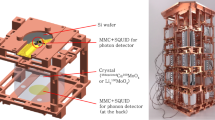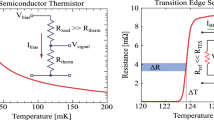Abstract
We present the development of a dual-detector system designed for investigating the spectral shape of forbidden non-unique beta decays. Two PbMoO\(_4\) scintillating crystals were carefully prepared for heat and light detection at milli-Kelvin (mK) temperatures. Notably, one crystal was synthesized using archaeological lead, while the other was composed of natural modern lead. The significance of employing two crystals lies in their identical dimensions and proximity, resulting in similar environmental background exposure. Their distinct internal radioactivities, particularly associated with \(^{210}\)Pb, introduce a distinguishing factor between the spectra measured in the two detectors. Our detection method includes achieving clear particle identification through the relative amplitudes of light and heat signals for both crystals. This report compares the electron-induced spectra within energy regions both below and above the endpoint of \(^{210}\)Bi beta decay. This comparative study provides valuable insights into an exact measurement of the \(^{210}\)Bi decay spectrum, forbidden non-unique beta decay.




Similar content being viewed by others
Data Availability
Data that support the findings of this study have been deposited in Institute for Basic Science.
References
P. Herczeg, Prog. Particle Nucl. Phys. 46(2), 413 (2001). https://doi.org/10.1016/S0146-6410(01)00149-1.
A. Falkowski, M. González-Alonso, O. Naviliat-Cuncic, J. High Energy Phys. 2021(4), 1 (2021). https://doi.org/10.1007/JHEP04(2021)126
M.A. Geyh, H. Schleicher, Absolute Age Determination: Physical and Chemical Dating Methods and Their Application (Springer, Berlin, Heidelberg, 2012). https://doi.org/10.1007/978-3-642-74826-4
X. Mougeot, Phys. Rev. C 91(5), 055504 (2015). https://doi.org/10.1103/PhysRevC.91.055504
J.T. Suhonen, Front. Phys. 5, 55 (2017). https://doi.org/10.3389/fphy.2017.00055
J. Suhonen, J. Kostensalo, Front. Phys. 7, 29 (2019). https://doi.org/10.3389/fphy.2019.00029
J. Kostensalo, J. Suhonen, Int. J. Mod. Phys. A 33(09), 1843008 (2018). https://doi.org/10.1142/S0217751X1843008X
M.M. Bé, V. Chisté, C. Dulieu, et al., Table of radionuclides (Vol. 4-A= 133 to 252) (2008)
E. Aprile, J. Aalbers, F. Agostini et al., Phys. Rev. D 102(7), 072004 (2020). https://doi.org/10.1103/PhysRevD.102.072004
B. Bhattacherjee, R. Sengupta, Phys. Lett. B 817, 136305 (2021). https://doi.org/10.1016/j.physletb.2021.136305
B. Collaboration, Nature 587(7835), 577 (2020). https://doi.org/10.1038/s41586-020-2934-0
K. Bunzl, W. Kracke, Nucl. Instrum. Methods A 238(1), 191 (1985). https://doi.org/10.1016/0168-9002(85)91049-6.
D. McCammon, Thermal Equilibrium Calorimeters—An Introduction (Springer, Berlin, Heidelberg, 2005)
Y.H. Kim, S.J. Lee, B. Yang, Supercond. Sci. Technol. 35(6), 063001 (2022). https://doi.org/10.1088/1361-6668/ac6a1c
L. Pattavina, J.W. Beeman, M. Clemenza et al., Eur. Phys. J. A 55(8), 1 (2019). https://doi.org/10.1140/epja/i2019-12809-0
M. Laubenstein, M. Hult, J. Gasparro et al., Appl. Radiat. Isot. 61(2), 167 (2004). https://doi.org/10.1016/j.apradiso.2004.03.039
S.G. Kim, J.A. Jeon, H.B. Kim et al., IEEE Trans. Appl. Supercond. 31(5), 1 (2021). https://doi.org/10.1109/TASC.2021.3066179
V. Shlegel, Y. Borovlev, D. Grigoriev et al., J. Instrum. 12(08), C08011 (2017). https://doi.org/10.1088/1748-0221/12/08/c08011
H.L. Kim, H.J. Kim, I. Kim et al., J. Low Temp. Phys. 199(3), 1082 (2020)
A. Khan, D.J. Daniel, H. Kim et al., Radiat. Meas. 123, 34 (2019)
W. Kim, S. Kim, B. Sharma et al., J. Instrum. 17(04), P04004 (2022). https://doi.org/10.1088/1748-0221/17/04/P04004
A. Grau Carles, Nucl. Instrum. Methods A 551(2), 312 (2005). https://doi.org/10.1016/j.nima.2005.05.070
L. Gironi, J. Low Temp. Phys. 167, 504 (2012). https://doi.org/10.1007/s10909-012-0478-x
H.L. Kim, G.B. Kim, H.J. Kim et al., IEEE Trans. Nucl. Sci. 65(2), 766 (2018). https://doi.org/10.1109/TNS.2017.2788898
M. Croce, E. Bond, A. Hoover et al., Nucl. Instrum. Methods A 784, 151 (2015). https://doi.org/10.1016/j.nima.2014.12.059. https://www.sciencedirect.com/science/article/pii/S0168900214015149. Symposium on Radiation Measurements and Applications 2014 (SORMA XV)
Acknowledgements
This research is supported by the Institute for Basic Science (IBS) under project codes IBS-R016-A2. The work at NIIC was supported by the Ministry of Science and Higher Education of the Russian Federation N121031700314-5.
Author information
Authors and Affiliations
Contributions
H.L. Kim wrote the main manuscript text and prepared figures. All authors reviewed and revised the manuscript and figures.
Corresponding author
Ethics declarations
Conflict of interest
This research is supported by the Institute for Basic Science (IBS) under project codes IBS-R016-A2. The work at NIIC was supported by the Ministry of Science and Higher Education of the Russian Federation N121031700314-5.
Additional information
Publisher's Note
Springer Nature remains neutral with regard to jurisdictional claims in published maps and institutional affiliations.
Rights and permissions
Springer Nature or its licensor (e.g. a society or other partner) holds exclusive rights to this article under a publishing agreement with the author(s) or other rightsholder(s); author self-archiving of the accepted manuscript version of this article is solely governed by the terms of such publishing agreement and applicable law.
About this article
Cite this article
Kim, H.L., Kim, H.J., Kim, W.T. et al. Development of a Dual Cryogenic Detection System for the Forbidden Non-unique \(\beta\)-Decay Spectrum Study. J Low Temp Phys (2024). https://doi.org/10.1007/s10909-024-03139-5
Received:
Accepted:
Published:
DOI: https://doi.org/10.1007/s10909-024-03139-5




